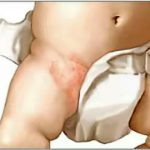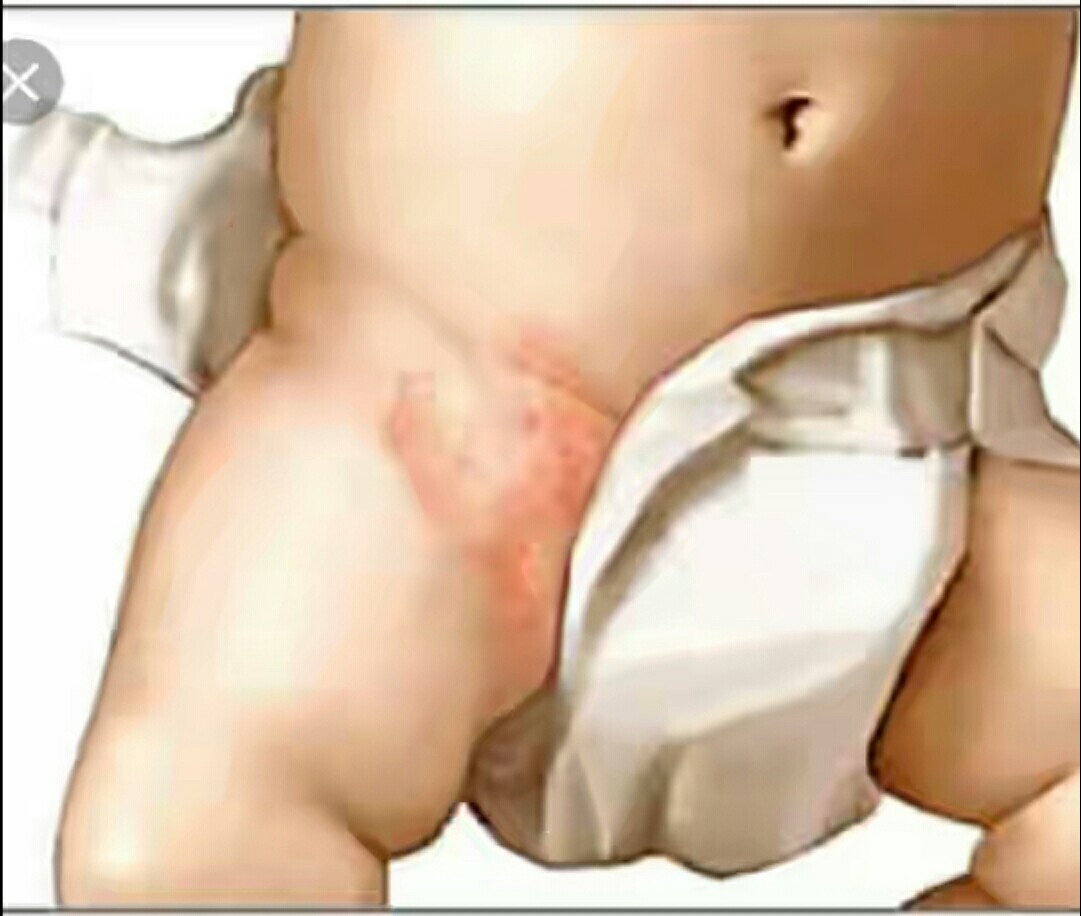Diaper rash is an inflammatory reaction localized to the area of skin usually covered by the diaper.
Don’t panic, it is a common skin problem in babies and clears when treated with the right creams, ointments and other natural remedies.
It has many causes, including infections (yeast, bacterial, or viral), friction irritation, chemical allergies (perfumes, soaps), sweat, decomposed urine, and plugged sweat glands.
Most diaper rash problems can be solved by cleansing the skin with nonperfumed, gentle products; changing diapers frequently; and exposing the affected skin area to air.
Commercially available diaper rash ointments are helpful for treatment but may actually cause further irritation if not used on the according to prescription.
Diaper rashes is also called diaper dermatitis.
Signs & Symptoms of diaper rash
Diaper rash is characterized by the following:
Skin signs. Diaper rash is marked by red, tender-looking skin in the diaper region — buttocks, thighs and genitals.
Changes in your baby’s disposition. You may notice your baby seems more uncomfortable than usual, especially during diaper changes.
A baby with a diaper rash often fusses or cries when the diaper area is washed or touched.
Causes of nappy rash
Diaper rash can be traced to a number of sources, including:
#Irritation from stool and urine: Prolonged exposure to urine or stool can irritate a baby’s sensitive skin. Your baby may be more prone to diaper rash if he or she is experiencing frequent bowel movements or diarrhea because feces are more irritating than urine.
#Chafing or rubbing: Tightfitting diapers or clothing that rubs against the skin can lead to a rash.
Irritation from a new product. Your baby’s skin may react to baby wipes, a new brand of disposable diapers, or a detergent, bleach or fabric softener used to launder cloth diapers. Other substances that can add to the problem include ingredients found in some baby lotions, powders and oils.
#Bacterial or yeast (fungal) infection:What begins as a simple skin infection may spread to the surrounding region. The area covered by a diaper — buttocks, thighs and genitals — is especially vulnerable because it’s warm and moist, making a perfect breeding ground for bacteria and yeast. These rashes can be found within the creases of the skin, and there may be red dots scattered around the creases.

#Introduction of new foods:As babies start to eat solid foods, the content of their stool changes. This increases the likelihood of diaper rash. Changes in your baby’s diet can also increase the frequency of stools, which can lead to diaper rash. If your baby is breast-fed, he or she may develop diaper rash in response to something the mother has eaten.
#Sensitive skin:Babies with skin conditions, such as atopic dermatitis or seborrheic dermatitis (eczema), may be more likely to develop diaper rash. However, the irritated skin of atopic dermatitis and eczema primarily affects areas other than the diaper area.
#Use of antibiotics:Antibiotics kill bacteria — the good kinds as well as the bad. When a baby takes antibiotics, bacteria that keep yeast growth in check may be depleted, resulting in diaper rash due to yeast infection. Antibiotic use also increases the risk of diarrhea. Breast-fed babies whose mothers take antibiotics are also at increased risk of diaper rash.
How To Cure diaper rashes
#Petroleum Jelly
Many pediatricians recommend applying a thin layer of protective coating on the baby’s soft skin every time you change a diaper. Petroleum jelly is perfect for this purpose. It will help protect the diaper area from the irritating effects of urine and feces.
After removing a soiled diaper, clean your baby’s bottom with warm water.
Dry it well with a cotton towel, and then apply petroleum jelly.Do this every time your baby needs a diaper changed, and the diaper rash will heal quickly.
#Cornstarch
Cornstarch absorbs moisture, making it a great treatment for diaper rash. It will help keep your baby’s skin dry, reduce diaper friction and prevent diaper rash.
Remove the soiled diaper and wash your baby’s bottom with lukewarm water.
Carefully blot the skin dry with another cloth. Allow the skin to further dry naturally for a few moments.
Lightly sprinkle cornstarch directly on the skin before putting a fresh diaper in place.
Do this each time you change a diaper until the skin fully heals.
#Coconut Oil
Coconut oil has antifungal and antimicrobial properties, and hence can be used to treat diaper rash. It can also have a soothing and healing effect on the baby’s soft skin.
Coconut oil works like a great moisturizer. Gently apply some coconut oil on the diaper area several times a day.
You can even add several tablespoons of coconut oil to bath water for added moisturizing. It will help kill yeast like Candida that causes diaper rash, too.
�#Trust the Moisturizing Goodness of Shea Butter
Shea butter has antifungal, anti-inflammatory, and yeast-killing properties that can help prevent and get rid of a diaper rash. It also has beneficial vegetable fats that can improve the circulation, promote cell regeneration, and helps the skin to heal.
Wash your baby’s bottom with mild soap and lukewarm water. Allow the area to dry naturally.
Rub pure shea butter gently in your hands until it melts. Then, press your hands on the affected area, rubbing the shea butter on the irritated skin.
Leave it on for a few minutes, and then put on a fresh diaper.
#Aloe vera and witch hazel
A study involving over 300 children showed that applying witch hazel (winter bloom) and aloe Vera to affected areas help clear diaper rashes.
#Creams and ointments
Creams like zinc oxide containing creams like sudocrem is very effective for diaper rashes. Baby tribotan, Lotrimin, vacation and bepanthen are effective for treating diaper rashes.
Sudocrem is clinically proven to soothe and heal your baby’s delicate skin and works in three simple ways: an emollient soothes sore or inflamed skin; its ingredients are recognised for their healing properties; and a mild local anaesthetic helps to ease pain and irritation.
#Other natural remedies
Research is ongoing to check if evening primrose a mixture beewax, honey, olive oil will cure nappy rash. Breast milk has also been suggested to soothe and clear nappy rash.
Caveat: Please see a doctor if you notice the rash is unusual, discharges pus, oozes, baby is restless and cries inconsolably, bleeds, and is accompanied by fever.
Source: MayoClinic
























